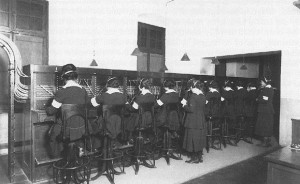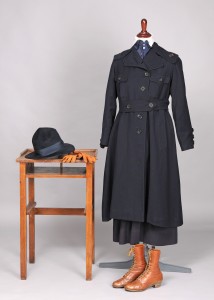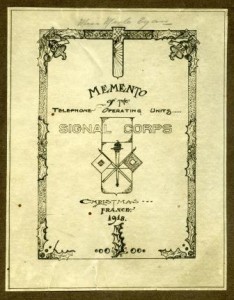
The story of women’s military service during World War II is relatively well known; less familiar is the story of the women who served during World War I, sometimes on or near the front lines. During World War I, over twenty-five thousand women worked for American forces or support organizations in Europe. These women performed integral work and helped chip away at gender stereotypes, paving the way for the more famous WACs and WAVEs of World War II.
Among those serving during World War I was Merle Egan of Helena, a telephone switchboard operator for the Army Signal Corps. A vitally important technology to U.S. military operations, telephones allowed officers to communicate across battlefields, between dispersed units, and with other allied forces. Unfortunately, war had devastated the French telephone system, so in 1917, when the U.S. Army was building up its forces in France, Gen. John Pershing ordered the construction of an American telephone system throughout the country.
The creation of a military telephone system opened up new opportunity for female service since civilian telephone operators were almost exclusively female. As Col. Parker Hitt, chief signal officer of the U.S. First Army, explained: “[A]n Army telephone central would have to have American women operators to be a success. Our experience in Paris with the untrained and undisciplined English-speaking French women operators, and experience elsewhere with the willing but untrained men operators was almost disastrous.” Thus, in November 1917, General Pershing requested that the War Department deploy one hundred French-speaking American women with telephone operating experience. Thousands of women applied and the first of these “Hello Girls” traveled overseas in the spring of 1918.

Merle Egan had eleven years of telephone operating experience when General Pershing put out the call for female operators. She trained in the summer of 1918 and headed to France that August. “As we sailed out of the harbor past the Statue of Liberty,” she recalled in later years, “there was an emotional tension experienced, I am sure by every Veteran who has served overseas. For some, there would be no returning but we knew we were answering our country’s call and we were proud of that mission.”
Egan docked in Liverpool and then went on to Paris before arriving at her station in Tours. She expected to serve as a telephone operator, but because of her technological expertise (Montana’s rural switchboards were very much like the primitive switchboards used in the field), she ended up instructing male soldiers in switchboard operation instead. The men were initially hostile: “‘Where’s my skirt?’ was their standard greeting. . . . [After] I reminded them that any soldier could carry a gun but the safety of a whole division might depend on the switchboard one of them was operating I had no more trouble.”
Two days after the November 11, 1918, armistice, Egan was awestruck to learn that she was being reassigned to the position of chief operator for the American Peace Commission in Paris. Looking back, she recalled, “Even now, after more than fifty years, it seems incredible that a young woman from a small city in Montana could rate an assignment that would involve telephone service to not only the outstanding men of our own country, but the world. Calls from President Wilson’s residence to Lloyd George of England, to Clemenceau of France and Orlando of Italy were a daily occurrence.”
Egan served in Paris until late May 1919, always assuming that on her return home she would be treated as veteran. It was not to be. Once back in Montana, she married H. R. Anderson, also an employee of the Mountain States Telephone Company. She recalled that her new husband was “very proud of my service” and “wrote one day to the Army to obtain my victory medal. We were astounded to receive the Army’s reply that I was a civilian employee. This, I believe, was my first indication that my former military status was in question. This was an even greater shock since I had just a few weeks earlier received a citation from General Pershing for Meritorious Service.”

Jarred by the army’s decision to label its female operators civilians, Merle Egan Anderson began a lifelong quest for formal recognition of the Hello Girls’ military service and veteran status. The evidence for her case was overwhelming. She had been sworn in by the adjutant general of the Montana National Guard. She had worn a military uniform with army buttons and the Signal Corps’ insignia. She had traveled to Europe on a ship that carried seven thousand male troops. She had an injured toe that was treated in an army hospital. The Hello Girls all followed military regulations, were subject to court-martial, and “were at all times at under the command of male Army Signal Corps officers and constantly reminded by them that we were in the Army.” Even after she returned to the United States, Anderson remembers that, “when I protested a routing in my travel orders, I was told, ‘Young lady you are still in the Army.’”
In spite of the seemingly obvious evidence, the fight for veteran status took six decades. According to historian Lettie Gavin (who credits Anderson for “leading the charge”), “More than fifty bills granting veteran status to the Hello Girls were introduced in Congress over the years, but none was passed.” Finally, with help from veterans’ groups and the National Organization for Women, the Hello Girls received veteran status in 1977. By the time their veterans’ benefits had been processed in 1979, only 18 of the 223 women who had served in the Signal Corp were still alive. Fortunately, Merle Anderson was one. She died in 1986, an acknowledged veteran of the U.S. Army. AH
You can learn more about the work of telephone operators, from whose ranks Merle Egan Anderson came, by reading “Number Please: Women Telephone Operators.”
Read about the experiences of Montana servicewomen during World War II in “You Have to Take What They Send You Now Days: Montana Women’s Service in World War II” and the efforts to commemorate that service in “Doris Brander and the Fight to Honor Women’s Military Service.”
Learn more about other opportunities World War I opened for women in “Like Father Like Daughter: Women Who Worked for the Northern Pacific Railroad.”
Sources
Affidavit of Merle Egan Anderson, State of Washington, County of King. March 29, 1976. Copy courtesy Mark Hough.
“An All-Telephone Wedding.” Mountain States Monitor, n.d., 21. Copy courtesy Mark Hough.
Anderson, Merle. “The Army’s Forgotten Women,” n.d., t.s. Copy courtesy Mark Hough.
___________. “Battling the Pentagon,” n.d., t.s. Copy courtesy Mark Hough.
Evans, Martin Marix. American Voices of World War I: Primary Source Documents, 1917-1920. London: Fitzroy Dearborn Publishers, 2001.
Frahm, Jill. “The Hello Girls: Women Telephone Operators with the American Expeditionary Forces during World War I.” Journal of the Gilded Age and Progressive Era 3, no. 3 (July 2004), 271-93.
Gavin, Lettie. American Women in World War I: They Also Served. Niwot: University Press of Colorado, 1997.
Zeiger, Susan. In Uncle Sam’s Service: Women Workers with the American Expeditionary Forces, 1917-1919. Philadelphia: University of Pennsylvania Press, 2004.